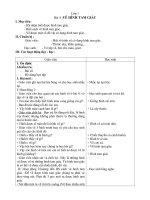- Trang chủ >>
- Mầm non - Tiểu học >>
- Lớp 5
5 1 4 famous women athletes
Bạn đang xem bản rút gọn của tài liệu. Xem và tải ngay bản đầy đủ của tài liệu tại đây (3.81 MB, 14 trang )
Suggested levels for Guided Reading, DRA,™
Lexile,® and Reading Recovery™ are provided
in the Pearson Scott Foresman Leveling Guide.
Biography
Famous
Women
Athletes
Genre
Biography
Comprehension
Skills and Strategy
• Sequence of Events
• Compare and
Contrast
• Ask Questions
Text Features
• Captions
• Heads
• Glossary
Scott Foresman Reading Street 5.1.4
ISBN 0-328-13512-7
ì<(sk$m)=bdfbch< +^-Ä-U-Ä-U
by Kara Race-Moore
Reader Response
1. Using a graphic organizer like the one below, place
this sequence of events in the proper order: Toni
Stone gets a hit off of Satchel Paige; Gertrude Ederle
swims the English Channel; Billie Jean King helps
establish the Women’s Sports Foundation; Roberta
Gibb runs in the Boston Marathon; Althea Gibson
qualifies to play at Wimbledon.
Famous Women Athletes
2. What questions would you have for the official who
tried to drag Katherine Switzer from the marathon?
3. Unique starts with the letters uni-. What other words
by Kara Race-Moore
do you know that start with those letters? Write
sentences for two of them.
4. Choose one of this book’s photographs and explain
how it adds to what you have learned from the text.
Editorial Offices: Glenview, Illinois • Parsippany, New Jersey • New York, New York
Sales Offices: Needham, Massachusetts • Duluth, Georgia • Glenview, Illinois
Coppell, Texas • Ontario, California • Mesa, Arizona
Women in Sports: A Brief Overview
In the 1800s women were allowed to play very
few organized sports. They could play croquet and
badminton or enter archery tournaments. Most
other sports were restricted to men only. And only
men were allowed to compete at the first modern
Olympic Games, held in 1896.
By the beginning of the 1900s, change was in the
air. Women were working for the right to vote, own
property, and work for the same wages as men. They
were also fighting for the right to compete in sports.
The 1900 Olympics showed signs of progess. At those
Olympic Games, women were allowed to compete in
tennis, golf, sailing, equestrian events, and croquet.
Today, girls and women participate in all sports, at
all levels.
Every effort has been made to secure permission and provide appropriate credit for
photographic material. The publisher deeply regrets any omission and pledges to
correct errors called to its attention in subsequent editions.
Unless otherwise acknowledged, all photographs are the property of Scott Foresman,
a division of Pearson Education.
Photo locators denoted as follows: Top (T), Center (C), Bottom (B), Left (L), Right (R),
Background (Bkgd)
Opener: Corbis; 3 Library of Congress; 6 Getty Images; 7 Corbis; 11 Corbis; 12 Corbis;
14 Corbis; 15 Corbis; 17 Getty Images; 19 Getty Images; 21 Corbis; 22 Getty Images
ISBN: 0-328-13512-7
Copyright © Pearson Education, Inc.
All Rights Reserved. Printed in the United States of America. This publication is
protected by Copyright, and permission should be obtained from the publisher
prior to any prohibited reproduction, storage in a retrieval system, or transmission
in any form by any means, electronic, mechanical, photocopying, recording, or
likewise. For information regarding permission(s), write to: Permissions Department,
Scott Foresman, 1900 East Lake Avenue, Glenview, Illinois 60025.
2 3 4 5 6 7 8 9 10 V0G1 14 13 12 11 10 09 08 07 06 05
In the early 1900s,
golf was one of
the few sports that
women were allowed
to play.
3
Trudy Ederle: The Super Swimmer
Gertrude “Trudy” Caroline Ederle was born in
1906. She was a child of German immigrants living in
New York City.
Ederle learned to swim when she was very young.
At the age of twelve, she swam the eight-hundredyard freestyle in thirteen minutes and nineteen
seconds. This made her the youngest person to break
a world record.
Trudy held eighteen world swimming records by
the time she was seventeen. She was also a member
of the United States Olympic swimming team. She
won a gold medal and two bronze medals at the
1924 Olympics.
In 1925 Trudy tried to swim across the English
Channel. Although she failed, she refused to admit
weakness. On August 6, 1926, she set off again from
the coast of France. She was nineteen. The water was
very rough that day. Trudy would not quit and swam
on despite big waves and seasickness.
It took Ederle fourteen hours and thirty-one
minutes to swim the thirty-five miles that separated
England from France. Her time was two hours faster
than the previous record set in 1875 by a British Navy
captain.
Trudy had proven that she was a great swimmer.
She became an international celebrity overnight. She
returned home to America as the first major sports
heroine. Thousands of people lined the streets of
New York City to cheer when she arrived home.
Ederle was inducted into the International
Swimming Hall of Fame in 1965. She joined the
International Women’s Sports Hall of Fame in 1980.
She was one of the first women athletes to be
recognized. But she quickly was followed by others.
Trudy Ederle
4
5
Babe Didrikson
Babe Didrikson: The Great Athlete
Mildred “Babe” Didrikson was born in 1914 in
Port Arthur, Texas. She was given the nickname
“Babe” because people thought she played baseball
as well as Babe Ruth. As a child Didrikson played
basketball, golf, and baseball. She also did track and
field, diving, swimming, tennis, and bowling.
Babe won two gold medals for track and field
in the 1932 Olympics. She would have won a third
but was disqualified by the high jump judges. They
disqualified her because they thought her style of
diving headfirst over the bar was inappropriate!
After the Olympics, Babe became a professional
golfer. She was the first American woman to win the
British Women’s Amateur Tournament. As a golfer
Didrikson broke the standards for how a “lady”
played golf. She hit long drives when women were
expected to take dainty shots.
6
Didrikson didn’t care that people were shocked
by her long drives. She was determined to win. She
knew that she would do better by hitting the ball
as far as she could. She won fifty-five tournaments,
including ten majors. Three of them were U.S. Opens.
Didrikson was never afraid to speak her mind.
Then she’d show people what she could do. In
1949 she helped form the Ladies Professional Golf
Association to support women’s golf.
Babe spent the last three
years of her life battling
cancer, but she kept playing
golf. She had surgery to
try to remove the cancer.
Afterward, she returned to
the golf course and won the
U.S. Women’s Open in 1954.
Didrikson died in 1956. She is
still remembered as one of the
greatest athletes ever, male or
female.
Babe Didrikson changed women’s
golf forever with her long drives.
7
Women’s Baseball: A League of Their Own
While Babe Didrikson was changing women’s golf,
other women were breaking into baseball. During
World War II many major league baseball players
went to war. Chicago Cubs owner Phil Wrigley set up
the All-American Girls Professional Baseball League
(AAGPBL) in 1943. He was worried that there weren’t
going to be enough men to play baseball during the
war.
Dorothy Kamenshek, born in 1925, was one of
the AAGPBL’s best players. Kamenshek played first
base. She won back-to-back batting titles in 1946
and 1947. She was an excellent hitter and rarely
struck out. Dorothy could bunt the ball or smack it
deep into the outfield. She
could make any hit her
team needed. Her team,
the Rockford Peaches, won
four championships during
her ten-year career.
In 1950 the Peaches lost the sixth game of
the championship series. Kamenshek rallied her
teammates to win the final game. She hit two
singles, a triple, and a home run, driving in five runs.
Dorothy had to wear a back brace because of injuries
in her final season in 1951. Even so, she was able to
hit for a .345 batting average while stealing sixtythree bases.
Ticket sales to women’s baseball games began to
decline in the early 1950s. In 1954 the AAGPBL was
shut down. Still, their memory lived on. Kamenshek
and the Peaches became the inspiration for the hit
movie A League of Their Own.
Women’s baseball enjoyed great
success during the 1940s.
8
9
Toni Stone: Good Enough to Hit Paige
Toni Stone was another baseball player who
proved women could play what had been a men’s
only game. She also had the added obstacle of being
African American. Toni was born Marcenia Lyle in
St. Paul, Minnesota, in 1921. She later adopted the
name Toni Stone.
Toni loved baseball. When she was ten she played
in a league sponsored by a cereal company. She
would practice anywhere, even in old ball parks with
rickety benches and no markings on the field.
Stone became the first woman to play for a men’s
big-league team. Syd Pollack was the owner of
the Negro American League’s Indianapolis Clowns.
He signed her to play second base in 1953. Pollack
signed her up partly as a gimmick to attract more
sales. But Stone soon proved to be one of the team’s
best players.
Toni had to put up with the mocking from
other players. Teammates would tell her that she
belonged in the kitchen. But Toni refused to quit
the game she loved.
10
Toni Stone was a good enough batter to get a hit off of the
legendary Satchel Paige in 1953.
In 1953 Toni had the chance to bat against the
legendary pitcher Satchel Paige. It was her most
memorable moment playing baseball. Paige had a
fastball that almost no one could hit. He would ask
batters how they wanted him to throw the ball—
high, low, or down the middle. He would complete
his windup and throw what the players asked for.
They still couldn’t hit the ball.
When Stone went to bat against Paige, she
jokingly asked only that he not hurt her. Yet Toni got
a hit right over second base! She was the only player
to get a hit off of Paige during that game.
Stone was inducted into the International
Women’s Sports Hall of Fame in 1993. Three years
later she died.
11
Althea Gibson: Pioneer in Women’s Tennis
Another African American woman athlete who
broke records and expectations was Althea Gibson.
Althea was born in South Carolina in 1927. She grew
up in New York City.
As a young girl, Gibson often played paddle
tennis. She once won a tournament. Buddy Walker,
a Harlem jazz musician, noticed her playing and
suggested she might do well at regular tennis.
Althea learned to play at Harlem’s Cosmopolitan
Tennis Club. She became
very good. She went on to
win the American Tennis
Association’s women’s
singles tournament ten
years in a row.
By 1951 Althea was at
the top of her game. That
year she qualified to enter
the English tournament at
Wimbledon. She became
the first African American
to play at Wimbledon.
In 1955 Gibson toured the world as a member of
a national tennis team supported by the U.S. State
Department. Later, she won many international
events, including the French, English, and U.S.
championships. In 1957 she won the doubles and
singles events at Wimbledon. She returned home a
national heroine. Her hometown greeted her with a
ticker tape parade.
Althea Gibson was inducted into the National
Lawn Tennis Hall of Fame, the International Tennis
Hall of Fame, and the Black Athletes Hall of Fame.
Gibson died in 2003, knowing of
the tennis victories of Serena and
Venus Williams. The Williams sisters’
successes are possible because of
the groundbreaking work of Althea
Gibson. Gibson was a unique athlete
who broke through many barriers in
women’s sports.
Althea Gibson was a dominant
tennis player during the 1950s.
12
13
Then, in 1974, King played a key role in helping
to establish the Women’s Sports Foundation, or WSF.
The WSF works to make it possible for all girls and
women to participate in sports.
Billie Jean King won thirty-nine Grand Slam titles
and 695 match victories during a sports career that
lasted two decades. By helping to found the WSF,
King ensured that the women who followed her
would have an easier time entering the sports world.
Even now King still helps promote women’s athletics.
Billie Jean King’s win against Bobby Riggs was nationally televised.
Billie Jean King: A Tennis King
Billie Jean King was born in 1943. She was the
daughter of a fireman and a homemaker. She grew
up to become a successful professional tennis player.
It angered her that men earned larger prizes for
winning tennis tournaments than women did. In
1970, King and several other women tennis players
were upset that the tournament judges were still
not giving equal prizes. So, they established the first
successful women’s professional tennis tour.
In 1971 King became the first female athlete to
win more than $100,000 in annual prize money.
Her most famous moment as a tennis player came
in 1973. That year she beat Bobby Riggs in a tennis
match titled the “Battle of the Sexes.” The match
was nationally televised. King’s win proved to the
whole country that women could excel at sports too.
King had been nervous before the match, but she
found the confidence to play, and won.
14
15
Rosemary Casals: Rising to Greatness
Rosemary Casals, an Hispanic tennis player,
energized the sport of tennis as she fought to prove
herself on the courts.
Rosemary was born in 1948 in San Francisco,
California. Her parents were immigrants from El
Salvador. When Casals was only a year old, her
parents felt they were unable to care for her. So she
was raised by her Uncle Manuel and Aunt Maria.
Manuel taught Rosemary to play tennis. He remained
her coach throughout her career.
Casals felt different because she was poor. Other
children arrived at the public tennis courts dressed
in fancy clothes and carrying brand new rackets.
Rosemary did not have these things. She was also at
a disadvantage because she was shorter than almost
all the other players. Casals had to prove herself
through her game. And she did.
Rosemary rebelled against the traditions of tennis.
She played against older girls. She rebelled against
the “feeling” that tennis had at that time. She was
not what the fans or the players expected.
Despite coming from a poor background, Rosemary Casals rose
up to achieve tennis greatness.
16
17
Historically, tennis had been a sport for the
wealthy. Players wore expensive white outfits, and
the crowd would clap only rarely and very quietly.
Casals wore brightly colored outfits and expected
the crowd to show more enthusiasm for her hard
work. She was almost excluded from her first
Wimbledon games for not wearing white. Today,
bright outfits and cheering crowds are found at most
tennis tournaments. This is thanks in part to the
trailblazing work of Rosemary Casals.
In 1966, Casals started playing in doubles
tournaments with Billie Jean King. Casals and King
became one of the best doubles teams in the history
of women’s tennis.
Casals and King were a great match as
teammates. Casals also fought for the rights of
female tennis players. She worked with King to get
female tennis players the same prize money that
male tennis players received. Throughout her career
Casals worked to better the sport of women’s tennis.
After knee surgery in 1978, Casals took a break
from playing tennis. Since 1981 she has been
president of Sportswomen, Inc. This is a California
company she formed to promote tennis tournaments
for older female players. In 1990 she teamed up
again with Billie Jean King to win the U.S. Open
Senior women’s doubles championship.
Rosemary Casals created a
sensation in the world of tennis
with her brightly colored outfits.
18
19
Female Marathoners: Fighting to Race
Women such as Althea Gibson, Billie Jean King,
and Rosemary Casals fought for equality on the
tennis courts. At the same time, women such as
Roberta Gibb, Katherine Switzer, and Nina Kuscsik
fought for the right to run.
In the 1960s women were not allowed to run in
the Boston Marathon. Roberta Gibb decided to test
this. In 1966, after putting on a hooded sweatshirt
to hide her identity, she joined the race. She ran
the entire race. Afterward, officials refused to
acknowledge that a woman had run the Boston
Marathon.
The next year Katherine Switzer decided that she
wanted to run the race. On the race application she
wrote her name, ‘K. V. Switzer,’ so officials wouldn’t
know she was a woman. They sent her an official
number.
Four miles into the marathon, a race official
realized Switzer was a woman and tried to drag her
out of the race. She outran him while other runners
deliberately ran in front of the official to prevent
him from stopping her. Switzer finished the race.
Newspaper photographers took pictures of
Switzer while the marathon official tried to drag
her away. Despite this event, marathon officials
still refused to allow women to run. This led to a
five-year legal battle. Finally, in 1972 Nina Kuscsik
became the first woman to officially run in the
Boston Marathon.
Meanwhile Switzer continued to work for female
athletes’ rights. She convinced Avon, the world’s
largest cosmetics corporation, to sponsor a series of
women’s races. Today Switzer continues to run and
fight for equality.
Katherine Switzer had to fight off this
race official in order to finish the 1967
Boston Marathon.
20
21
Fu Mingxia: Diving Into Success
Fu Mingxia was born in 1978 in Wuhan, China.
She started diving before she knew how to swim.
To help, her coaches tied a rope around her waist so
they could pull her out of the water after her dives.
Mingxia said that when she first started diving
she was “scared to death.” According to the rules, a
diver could not climb back down the ladder once he
or she had climbed up. Mingxia was always afraid,
but never climbed back down the ladder.
When Mingxia was eleven she was selected
for the Chinese Junior diving team. Shortly after
she won a gold medal in platform diving at the
1990 Goodwill Games. Mingxia’s career as a world
champion diver had been launched.
Fu Mingxia conquered her fears to become an
Olympic diver.
22
Six months later Mingxia finished first in the
ten-meter platform competition at the 1991 world
championships. At twelve years old she had become
the youngest world champion ever. Next she won
a gold medal at the 1992 Olympics. She was the
youngest person to win an Olympic gold medal
since 1936. She was the youngest Olympic diving
champion ever.
At the 1996 Olympics, Mingxia won both the
ten-meter platform and three-meter springboard
diving event. Mingxia took the next few years off for
school. Then, in the 2000 Olympics, Mingxia again
took home gold in the three-meter springboard
diving event. Training and competing brought injuries
and hardship, but Mingxia always pressed on.
Over the past hundred years, female athletes have
broken down many barriers. From Ederle’s swimming
to Mingxia’s diving, they have inspired us with their
feats. Thanks to their pioneering efforts, today’s
women can participate in and excel at whichever
sports they choose!
23
Glossary
confidence n. firm belief
in yourself.
fastball n. a pitch thrown
at high speed.
mocking v. the act of
laughing at; making fun
of.
outfield n. the part of a
baseball field beyond the
diamond or infield.
Reader Response
unique adj. having no like
or equal; being the only
one of its kind.
weakness n. a weak
point; slight fault.
windup n. a swinging
movement of the arms
while twisting the body
just before pitching the
ball.
1. Using a graphic organizer like the one below, place
this sequence of events in the proper order: Toni
Stone gets a hit off of Satchel Paige; Gertrude Ederle
swims the English Channel; Billie Jean King helps
establish the Women’s Sports Foundation; Roberta
Gibb runs in the Boston Marathon; Althea Gibson
qualifies to play at Wimbledon.
2. What questions would you have for the official who
tried to drag Katherine Switzer from the marathon?
3. Unique starts with the letters uni-. What other words
do you know that start with those letters? Write
sentences for two of them.
4. Choose one of this book’s photographs and explain
how it adds to what you have learned from the text.
24









